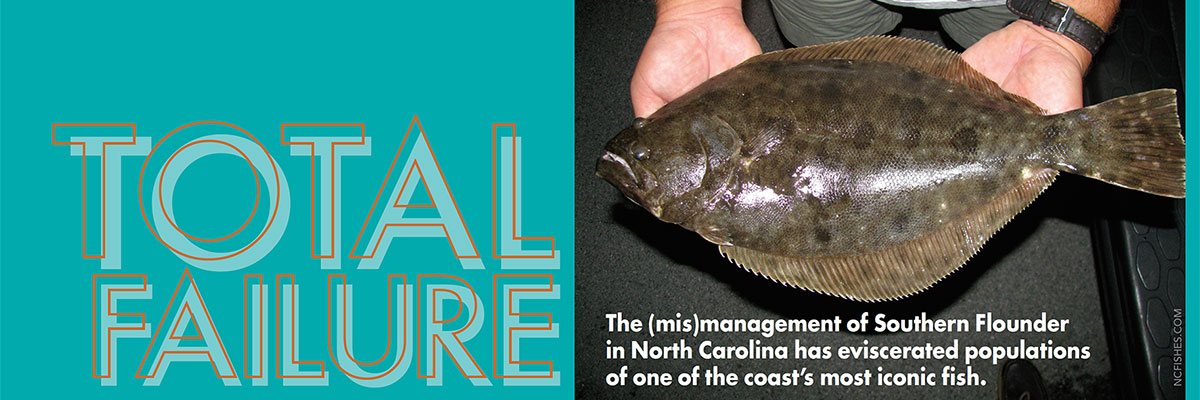Update: Management Plan for Iconic Southern Flounder Still in Ruins

The management plan for an overfished iconic species is still floundering and a moratorium on harvesting may be the only option to save the southern flounder population. North Carolina Wildlife Federation weighed in recently on the Southern Flounder Fishery Management Plan, noting Marine Fisheries Commissions’ numerous failures, inaccurate claims and practices that don’t even come close to hitting their target.
“Due to failures over many MFC meetings and decisions over the years, a moratorium on southern flounder harvest may very well be the only option moving forward if the second rebuilding deadline is expected to be met in 2028, 13 years after the original deadline,” said NCWF CEO Tim Gestwicki, in a Nov. 12 letter on Southern Flounder Fisheries Management.
NCWF also encourages reducing capacity in commercial fishery through license reform that protects and preserves fishermen who land and sell seafood and ends the ability to use commercial gear for personal use. The letter also notes the upcoming decisions on Amendment #2 to the Shrimp Fishery Management Plan “may be the single most critical reform needed in our state to rebuild and preserve fisheries for the future.”
Total Failure: Iconic Southern Flounder Fishery in Ruins
Originally published June 3, 2021
North Carolina’s management of its Southern Flounder populations has failed. This iconic fish—beloved for its sporting properties on hook and line, and its classic appearance on fried seafood plates for decades—is in a near freefall. Conflicts of interest have stonewalled science-based remedies to achieve sustainable harvests for all sectors, commercial anglers and recreational fishers alike.
Now, the unwieldy management process includes a hierarchical chain-of-command procedure from the Department of Environmental Quality (DEQ) to the Division of Marine Fisheries (DMF) to the Marine Fisheries Commission (MFC) that has inherent delays built into the administrative structure. The sad, yet entirely avoidable, result: North Carolina’s Southern Flounder is the poster fish for failed management.
The Fisheries Reform Act of 1997 (FRA) requires the creation and implementation of fishery management plans (FMPs) to manage and protect stocks of important species.
The FRA requires that an FMP for a species such as Southern Flounder end overfishing of that species within two years, and achieve a sustainable harvest within 10 years, but does not include any consequences for failure to meet those timelines. And that’s why we are where we are.
A step-by-step timeline of failure
2005: Southern Flounder FMP adopted with a goal to rebuild the Spawning Stock Biomass to the target biomass in 10 years and achieve sustainable harvest as required under the FRA. Four years later…
2009: DMF determines the stock is still overfished and the original FMP has failed. Four years later…
2013: Amendment 1 to the FMP approved by MFC. Target reductions in the commercial fishery remain unmet and Amendment 1 fails to end overfishing or achieve sustainable harvest. One year later…
2014: New stock assessment shows even worse mortality rates for the Southern Founder fishery, indicating no progress in rebuilding the stocks since 2005. One year later…
2015: MFC votes to develop a supplement to the FMP to further reduce harvest up to 60 percent. Having fallen short of achieving sustainable harvest by 2015, the 10-year-old FMP fails. One year later…
2016: In October, N.C. Fisheries Association files a lawsuit, and a judge orders a temporary injunction to any new regulations until a new Amendment is developed. Two years later…
2019: Amendment 2 to the FMP is developed to again phase-in an end to overfishing and achieve sustainable harvest by a new Department of Environmental Quality-extended deadline of 2028. DMF recommends a 62 percent reduction, inconsistent with the stock assessment. One year later…
2020: MFC adopts a 72 percent reduction. The harvest reduction in 2019 was only 34 percent, failing to meet the required reductions. Amendment 2 fails in the same way as Amendment 1 failed to end overfishing or achieve a sustainable harvest.
Sixteen years later and here we go again
Amendment 3 is now being developed but has excluded best management principles with ineffective measures being contemplated.
The original FMP for Southern Flounder was adopted in 2005 and amended twice—in 2013 and 2019—but landings from this fishery have continued to decline for half a decade past the original deadline for a sustainable harvest in 2015 set by the FRA. The 80 percent reduction in commercial landings from 1997 to 2019 doesn’t take into account bycatch mortality from trawling, use of nets, and releases, and therefore indicates that the North Carolina Southern Flounder fishery is in crisis.
The FMP for this species has been an abject failure, necessitating immediate biological remedies, comprehensive data analysis, and accountability to save this fishery for all.

